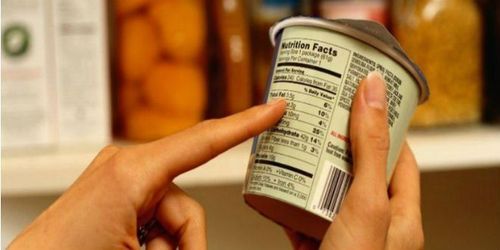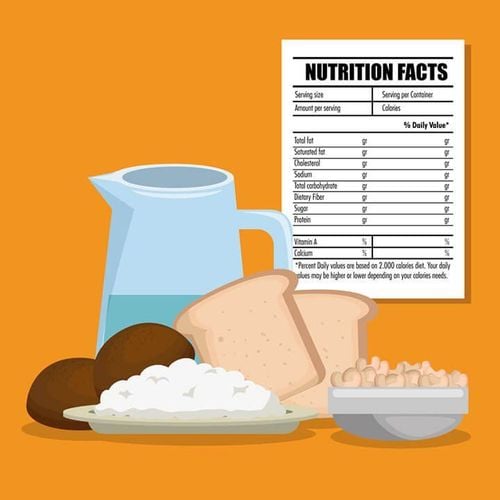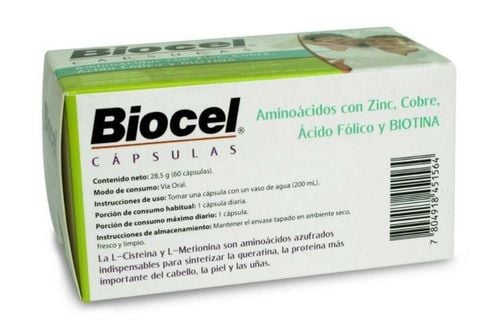This is an automatically translated article.
Information on food labels can help people make healthy food choices. The Nutrition Facts and Nutrition Facts panel can help you identify the foods that best meet your needs. Most importantly enjoy what you eat. However, baby food labels can be confusing.1. How to find out the nutritional value on food labels
There are two main ways to find out the nutritional value of the foods you eat through the nutrition facts panel and nutrition claims. In addition, many food products also have a DI Counter that shows the percentage of your daily vital nutrients (% DI) that one serving of the product will provide.1.1 Nutrition Facts This is a chart of the nutrient content found in most foods. The minimum information and layout of the Nutrition Facts panel are regulated by government food regulations. Nutritional information is provided per serving (manufacturer-defined servings) and per 100g. In addition, the recommended serving percentage of vitamins and minerals in the diet must be listed when the manufacturer makes a claim for vitamins or minerals in the product.
1.2 List of ingredients The ingredient list on food products identifies all the ingredients present in the food. The ingredients are listed in descending order of their amount in the food meaning the higher up the list, the greater the amount present in the food.
The percentage that certain ingredients contribute to the finished product must be labeled. Ingredients that should be labeled as a percentage include those that appear in the product's name, are often associated with the food, or are highlighted on the food label with text, pictures, or graphics. For example, the ingredient list for Weet-Bix Bites flavored cocoa-malt must include the percentage that cocoa and malt contribute to the finished product such as: Weet-Bix Bites - cocoa (2%), barley malt extract (0.5%).
There may also be cases when an ingredient, which is itself made up of two or more components, requires percentage labeling. An example of how this might appear is "fruit (25%) (apple pulp, dried apricots (1.4%), pectin,...). This means the percentage of apricots ( e.g. 1.4%) is the percentage of apricots in the finished product NOT the percentage of apricots in the fruit.

Danh sách thành phần trên các sản phẩm thực phẩm xác định tất cả các thành phần có trong thực phẩm
2. What is the "phase" baby food?
Food "stages" for babies correspond to the child's level of development.Stage 1 foods are made so that babies can get used to solids for the first time. They are pureed into a thick liquid for easy swallowing and are often a single ingredient to help isolate any reaction to the food. A baby's stage 1 food container is often smaller to reflect the portion the child eats. Stage 2 foods have a thicker consistency, designed for children who already have experience using stage 1 foods. These children have become more adept at moving food from the front. to the back of the mouth. Foods at this stage often combine 2 or more ingredients so that your baby can be exposed to new flavor mixes. Stage 3 foods have a more complex texture and are usually intended for older children who have already mastered chewing and swallowing skills.

Các "giai đoạn" thực phẩm cho trẻ tương ứng với mức độ phát triển của trẻ
3. What does "GMO" mean?
"GMO" stands for "genetically modified organism." This is a plant, animal, or other entity that has been modified in a laboratory rather than created naturally. Non-GMO means that the food is created without genetic engineering and does not contain ingredients derived from GMOs.Non-GMO Project Verified means the product meets the standards of the Non-GMO Project Product Verification program, the only third-party verification in North America for non-GMO foods and products.
4. What does "organic" mean?
The term "organic" has long been associated with food grown without pesticides. However, the USDA organic seal says more than that: the product and other ingredients in the packaging are grown without the use of genetically modified products, sewage sludge (a fertilizers), irradiation, synthetic fertilizers, or herbicides and must contain no artificial flavors, colors, or preservatives. Cattle are only fed 100% organic feed and no antibiotics or hormones are used.Different versions of the organic label include:
100% organic: The ingredients are all 100% organic. Organic: Ingredients that are at least 95 percent organic. Made with organic ingredients: Ingredients that are at least 70 percent organic.
5. Sugars
"Total sugar" refers to both natural and added sugars. Research supports minimizing the amount of calories consumed from added sugars. The American Heart Association recommends that children under 24 months old should not consume any added sugars.
Hiệp hội Tim mạch Hoa Kỳ khuyến cáo rằng trẻ em dưới 24 tháng tuổi không nên tiêu thụ bất kỳ loại đường bổ sung nào
6. What does "OU" mean?
"OU" stands for Orthodox Union, the largest and most widely recognized Kosher certification body in the world. The symbol Kosher means food that follows the Jewish dietary laws. Here are the different product designations:Organizational unit: Kosher products that do not contain meat or dairy products OU-D: Kosher dairy products OU-M or OU-Glatt: Kosher-style meat products
7. Vitamins and minerals listed on baby food labels
At the bottom of each Nutrition Facts label, you'll see a list of vitamins and minerals, along with amounts in grams, and a percentage of this amount that represents the FDA's "recommended daily value." These numbers are based on one serving of food for one of the following demographics:Infants to 12 months Ages 1 to 3 years Adults and children 4 years of age and older Pregnant women and children feed Labels on baby foods intended for babies 12 months and under will reflect that age. For example, the recommended daily value of calcium for children this age is 260 mg. One carrot containing 26 mg of calcium will provide 10% of the recommended daily value.
FDA requires manufacturers to ensure products contain vitamins and minerals including:
Vitamin D Calcium Iron Potassium Recent studies have found that many Americans are deficient in these four nutrients. Although not required by the FDA, other vitamins or minerals may also be listed on food labels.
8. Why aren't fat calories listed as nutrition facts on baby food labels?
Fat is considered a concentrated source of energy. Fat is essential for the growing fetus of a pregnant mother. And fat is essential for brain development because most of the brain is made up of fat. Parents don't need (and shouldn't) limit their children's fat intake.Research shows that type of fat is more important than total fat. Including a healthy mix of monounsaturated and polyunsaturated fats in the diet improves blood cholesterol levels, which is important even as children get older. Baby-friendly foods include avocados for monounsaturated fats and salmon or flaxseeds for polyunsaturated fats.
9. Nutritional Claims
Nutritional claims such as "low fat" or "high fiber" are often placed on food labels. This is called a 'nutrient claim' and most have a definition set by a government agency, known as Food Standards Australia New Zealand (FSANZ) that food manufacturers follow. player. The requirement states that any food label with a nutrition claim must include a nutrition fact sheet for additional information.Here are the criteria for the most common nutrient claims as defined by FSANZ or by the Australian Grocery Council's Code of Practice:
Good source of vitamins and minerals Good source of vitamins or minerals minerals Rich in protein Rich in carbohydrates Low in salt Source of fiber No artificial flavors High in fiber No artificial colors Very rich in fiber Low in fat Good source of vitamins and minerals means one serving contains zero less than 25% of the recommended dietary intake of vitamins or minerals. For example, "a good source of 5 vitamins" means that one serving of the product provides 25% of the RDI for the 5 vitamins. A source of a vitamin or mineral means that one serving of a food contains not less than 10% of the recommended dietary intake of a vitamin or mineral. For example, "source of calcium" means that one serving provides no less than 10% of the RDI for calcium.

Các tuyên bố về dinh dưỡng như "ít chất béo" hoặc "nhiều chất xơ" thường được ghi trên nhãn thực phẩm
10. Healthy food choices
Some parameters for healthy food choices:Fiber source means food containing at least 1.5g fiber per serving. High fiber means the food contains at least 3g of fiber per serving. Very high in fiber means the food contains at least 6g of fiber per serving. High protein content means the product contains at least 5g of protein per serving and contributes at least 12% of total energy from protein. Low salt means the food contains less than 120 mg of sodium per 100g. No artificial flavors means the food contains only natural flavors extracted from the food. No artificial colors means that the food contains only natural colors which are colorants extracted from natural matter and not synthetically processed. Low fat means the food contains less than 3g fat per 100g. Another commonly used nutrient claim is that high in carbohydrates means that the food is a good source of carbohydrates and provides most of the kilojoules (and calories) from carbohydrates.
For children to be healthy and develop well, it is necessary to have a nutritious diet in terms of quantity and quality balance. If children are not provided with adequate and balanced nutrients, it will lead to diseases of excess or lack of nutrients, which adversely affect the comprehensive development of children in terms of physical, mental and motor skills.
Children who do not eat properly are at risk of micro-mineral deficiency causing anorexia, growth retardation, malabsorption,... If they notice the above signs, parents should supplement their children with products. The supplement contains lysine, essential micro-minerals and vitamins such as zinc, chromium, selenium, and B vitamins to help fully meet the nutritional needs of children. At the same time, these essential vitamins also support digestion, enhance nutrient absorption, help improve anorexia, and help children eat well.
Parents can learn more:
Signs of zinc deficiency in children
Micronutrient deficiency and failure to gain weight in children
Please regularly visit Vinmec.com website and update useful information to take care of your child. Take care of the baby and the whole family.
Reference source: babycenter.com













